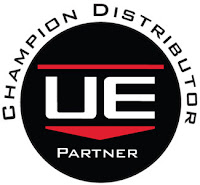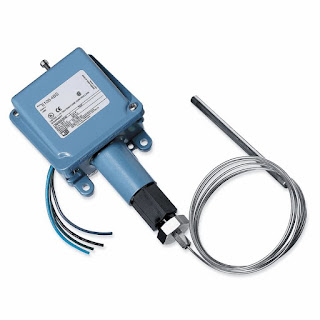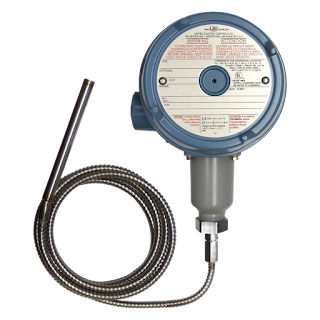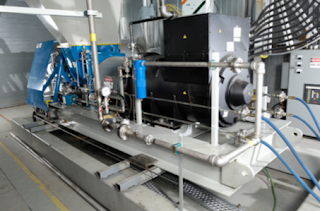Educational information on process control, industrial instrumentation, valves, valve automation and control valves. For additional information visit IvesEquipment.com or call 877-768-1600
Showing posts with label UE. Show all posts
Showing posts with label UE. Show all posts
United Electric Controls Product Catalog
 |
| Ives Equipment is a UE Champion Distributor |
You can download a PDF of the UE product catalog here, or view it online below.
Tried and True: Industrial Bulb and Capillary Temperature Switches
 |
| UE watertight and corrosion resistant temperature switch. |
One method of changing the state of an electrical switch from open to closed in response to a process temperature change is a bulb and capillary temperature switch. The change in state occurs in the mechanical switch when the temperature of a process control operation crosses a certain threshold. Bulb and capillary switches have the advantage of operating without requiring an excitation voltage, simplifying their use in a given application.
The physical operating principle behind the capillary thermostat relies on the use of a fluid. The fluid inside the thermostat expands or contracts in response to the temperature at the sensing bulb. The change in fluid volume produces a force upon a diaphragm or other mechanical transfer device. The diaphragm is connected to, and changes the status of, an adjoining circuit using a snap action switch.
Because of their simplicity and comparatively modest cost, commercial versions of bulb and capillary switches find application throughout residential and commercial settings. Some common applications include warming ovens, deep fat fryers, and water heaters.
 |
| UE hazardous area temperature switch. |
Industrial versions of bulb and capillary switches are fitted with appropriate housings for the installation environment. Housings designed for hazardous areas, drenching or submersion, high dust or high corrosive environments are standardly available. Many switching options exist as well, such as high current ratings, SPDT, DPDT, dual SPDT, adjustable deadbands, and internal or external adjustments.
Operation of the temperature switches is subject to a few limitations. The setpoint is most often fixed, so changing the setpoint accurately requires trial and error or a calibration procedure. The temperature range over which the switches are suitable is comparatively limited, with a matching of the bulb and capillary fluid system to the application temperature range a necessary task in product selection. Within its proper sphere of use, though, bulb and capillary temperature switches offer simple, reliable operation, with little requirement for maintenance.
Time-tested, and application proven, these simple mechanical devices are still strong candidates for applications in any temperature control process. As with any process instrument implementation, we strongly suggest you share your application requirements with a knowledgable product specialists for the best solution.
Upgrading to a United Electric (UE) Controls One Series from a Mechanical Pressure Switch
 This video below demonstrates how to replace an older on/off mechanical pressure switch and install the UE One Series.
This video below demonstrates how to replace an older on/off mechanical pressure switch and install the UE One Series.The One Series electronic pressure and temperature transmitter-switches set the standard for smart digital process monitoring. With a fully adjustable set point and deadband and 0.1% repeatability, the One Series performs in a wide variety of applications. Available in Type 4X enclosures approved for intrinsic safety, flameproof and non-incendive area classifications, these hybrid transmitter-switches are designed to provide transmitter, switch and gauge functions all-in-one rugged enclosure that can withstand the rigors of harsh and hazardous environments.
Each One Series model incorporates intelligent self-diagnostics and can report detected faults before they become major safety issues. Plug Port Detection protects against sensor clogging. Nuisance trip filtering reduces false and spurious signals. The ability to capture pressure spikes and valleys provides process information to aid in the commissioning and debugging process.
For more information, visit http://www.ivesequipment.com or call (877) 768-1600.
Enhance Control System Security Using Process Switches
 |
| Electro-mechanical switches do not have software or an operating system susceptible to cyber attack. |
Untied Electric Controls
This white paper looks at how open Microsoft technology used in virtually all contemporary control systems, such as distributed control systems (DCS) and supervisory control and data acquisition (SCADA), can mean less security. The paper explores why current solutions may not be up to the task of protection. It also shows how simple, yet reliable electro-mechanical switch-based protection can improve cyber defenses by complementing traditional techniques with another layer of protection independent of centralized control systems.
Better Technology, Less Security
A long running trend is behind the increasing vulnerability of control systems to hacking and other forms of cyber mischief. Centralized control systems are typically tied together through an open network and software that is susceptible to cyber-attack. What’s more, the network extends out beyond the plant floor. Indeed, a part of the plant floor network is increasingly reaching around the world, thanks to web-based tools and interfaces.
Networking adds extra capabilities, information sharing, and lowers the cost of commercial off-the-shelf components used in process control systems. Data from a control system can be fed into enterprise management software, enabling the use of business intelligence techniques to tackle problems and improve overall performance.
However, current networked systems are more vulnerable to attack than yesterday’s stand-alone and analog-based setups. This increased susceptibility arises from expanding exposure on two fronts. First, an open standardized network that can be accessed around the world for good can also be manipulated globally for bad. Second, the more complex a network becomes, in terms of connected devices and topology, the more likely it is that some vulnerability will open up, particularly if system updates are not deployed in a timely manner.
Perhaps the best known and most complete example of this in a SCADA setting is the Stuxnet worm, which was discovered in June 2010. Stuxnet infects computers through infected USB ash drives and exploits multiple Microsoft Windows security vulnerabilities. More recently, another worm related to Stuxnet dubbed Duqu was discovered by a Budapest University. Built on the same source code as Stuxnet, Duqu may be one of many malware worms floating in cyberspace ready to attack.
An investigation by the Idaho National Laboratory demonstrated potential physical damage with a 27-ton power generator by sending conflicting instructions governing speed and other characteristics that induced the generator to literally shake apart, destroying it. In a simulation, Sandia National Laboratory engineers showed that turning o a recirculation pump while upping heat could incapacitate an entire oil refinery by simply destroying a critical component.
Current Solutions Need Improvement
Traditional solutions are not as effective as they once were. One aspect of the traditional approach is to patch software to plug vulnerabilities. Doing this prevents an attacker from gaining control of a system through the use of a trick - such as a buffer overflow overloading the software – thereby allowing an attacker free reign.
Yet another approach is to employ firewalls and intrusion detection devices to keep intruders out and prevent the exploitation of weaknesses. Very sensitive and critical control applications are further hardened through network segregation to limit points of contact to the outside world, making the systems more secure. Costly redundant components and controllers can also be used, if control applications are vital enough to warrant the extra expense.
In today’s world, unfortunately, all of these tactics can – and do – fail due to the efforts of smart savvy attackers. On the software side, the list of vulnerabilities in Linux, Windows, iOS, Android and other operating systems is long and growing. Despite the valiant efforts of the control system suppliers, attacks can succeed if an un-patched operating system or applications exist inside a trusted area due to lax system upgrades.
In addition, the growth of newer technologies, such as fieldbus networks, industrial wireless networks, and mobile hand-held devices is another potential path for hackers. The new crop of safety instrumented systems (SIS) shift from separated analog systems to digital networking architectures may be susceptible to operating system weaknesses. Wireless networks are new and even with the extraordinary security measures included in the standards, only one entry point out of an infinite amount due to ubiquitous access points through sensors and mobile devices is needed to create havoc.
In total, this situation means that the most secure approach possible – network segregation – is much less effective.
Turning to Tried and True Technology
Clearly, there is a need to add to the defense against cyber-attack. Ideally, the defense would operate in the event of a compromised control system. The solution has to be fast acting, as even small delays can lead to damaged equipment, toxic environmental exposure, loss of life, and long downtimes. It also has to be reliable, working when needed and not triggering at the wrong times. Finally, it has to be hack-proof and support current infrastructure.
Electro-mechanical process switches, a robust and proven technology, meet all of these requirements. At first glance, this is somewhat surprising since the technology is not typically considered for cyber security. However, electro-mechanical switches do not have software or an operating system susceptible to cyber attack. When properly applied, electro-mechanical switches can provide safety functions independent of a central control system. There is no processor involved, which means there is nothing to hack. Electro-mechanical switches are also fast, tripping quickly when milliseconds count. What’s more, modern implementations, like United Electric’s 100, 120 and 400 Series
of pressure and temperature switches, have virtually no false positives. When these switches trip, it is because a safe operating limit has been exceeded, dangerous conditions exist, or both.
The key to this approach is the placement of switches so that they monitor suitable process parameters. They also must be connected so that they can take the appropriate action. In the event of an out-of-limit process condition, the switches will trip. Since the switches can power relays, they can be wired so as to shut down compressors, pumps, turbines or whatever is needed to correct the situation and limit the damage.
Of course, the choice of what parameters to measure and where to do so will be dictated by the particular process in question. Likewise, what to have a switch act upon will also be process specific. They could, for example, shut o a compressor to keep a vessel from an overpressure situation or they could trip relays to take an entire plant floor offline.
To see the power of this approach, consider that one of the first actions taken in Sandia National Laboratory oil refinery attack simulation was to put the system on manual, thereby overriding automated safeguards. This hack attempt would have failed, though, given an appropriately placed and configured electro-mechanical switch. The switch would have tripped once the temperature exceeded a set point. There would be nothing the attacker could have done.
As an added bonus, switches protect against both deliberate and accidental catastrophes. After all, they do not care why a temperature limit, for example, has been exceeded. The situation could be due to malicious hacking or the failure of a pump circulating coolant. In either case, though, the switch would take the same action and provide an emergency shutdown.
Conclusion
As has been shown, increasing connectivity and automation have brought bene ts, such as diagnostics, predictive maintenance, and process optimization to process control. However, by bridging the gap between control systems and the world, these advances have also made automated control systems vulnerable to attack. Traditional solutions may not be adequate to safeguard systems in an environment where multiple, rapidly evolving technologies combine to create many potential weak links.
The solution involves a properly designed safety layer of electro-mechanical process switches to complement traditional software solutions. Switches are fast, reliable, hack-proof, and act independent of the control system. Electro-mechanical switches should be considered as the primary or redundant layer to protect critical equipment in today’s dangerous landscape. So, while no control system today may be an island, electro-mechanical switches can, in effect, provide protection from intruders before they can cause damage.
Labels:
cyber security,
Delaware,
Maryland,
New Jersey,
New York,
Pennsylvania,
pressure switch,
process switch,
UE,
Virginia
PART 1: Setting Up and Operating the United Electric One Series Safety Transmitter
 |
| One Series Safety Transmitter |
The One Series Safety Transmitter is a pressure or temperature monitoring transmitter switch that provides a NAMUR NE 43 standard 4-20 mA analog output. Its programmable high-capacity solid-state safety relay output enables the fastest emergency shutdowns.
The One Series Safety Transmitter is certified for use in SIL 2 functional safety applications (HFT = 0), and is capable of SIL 3 applications when augmented by redundancy and voting logic. Its simple design means fewer nuisance trips — for greater safety, productivity, and throughput.
The One Series Safety Transmitter was designed with features that simplify installation, improve productivity, and eliminate nuisance trips. “I Am Working” sensor diagnostics with redundant data processing detect open, shorted, and plugged sensing elements.
The transmitter’s analog output conforms to the NAMUR NE 43 standard and provides process variable (PV) and detected-fault information. Discrete outputs provide a fail-safe (open) emergency shutdown when a fault is detected. Set point and deadband (reset point) are 100% programmable.
The instrument is password protected to prevent unwanted parameter changes; eliminating the risk of tampering. In addition, LED backlighting enhances viewing of process variables, parameters, and status in dimly lit areas.
- Fewer nuisance trips for greater productivity
- More affordable than adapting a process transmitter for SIS
- Internal relay for faster emergency shutdowns
- Higher safe failure fraction simplifies SIL achievement
For more information, contact:
Ives Equipment
(877) 768-1600
PART 2: Setting Up and Operating the United Electric One Series Safety Transmitter
 |
| One Series Safety Transmitter |
The One Series Safety Transmitter is a pressure or temperature monitoring transmitter switch that provides a NAMUR NE 43 standard 4-20 mA analog output. Its programmable high-capacity solid-state safety relay output enables the fastest emergency shutdowns.
The One Series Safety Transmitter is certified for use in SIL 2 functional safety applications (HFT = 0), and is capable of SIL 3 applications when augmented by redundancy and voting logic. Its simple design means fewer nuisance trips — for greater safety, productivity, and throughput.
The One Series Safety Transmitter was designed with features that simplify installation, improve productivity, and eliminate nuisance trips. “I Am Working” sensor diagnostics with redundant data processing detect open, shorted, and plugged sensing elements.
The transmitter’s analog output conforms to the NAMUR NE 43 standard and provides process variable (PV) and detected-fault information. Discrete outputs provide a fail-safe (open) emergency shutdown when a fault is detected. Set point and deadband (reset point) are 100% programmable.
The instrument is password protected to prevent unwanted parameter changes; eliminating the risk of tampering. In addition, LED backlighting enhances viewing of process variables, parameters, and status in dimly lit areas.
The Series One leads the market in process safety transmitters because:
- Fewer nuisance trips for greater productivity
- More affordable than adapting a process transmitter for SIS
- Internal relay for faster emergency shutdowns
- Higher safe failure fraction simplifies SIL achievement
For more information, contact:
Ives Equipment
(877) 768-1600
Pressure and Temperature Transmitters/Switches - Safety Right Out of the Box
 |
| UEC Safety Transmitter |
In the sensor subsystem for example, United Electric’s certified safety transmitter for pressure or temperature has opened up a new, less costly, less complex path for designers, I&C engineers, and maintenance personnel. It has something very unique. In addition to a 4-20 mA output, is has an embedded programmable high-capacity relay which exida has certified as a safety variable output. Now you have a device that provides designers the option of a hard wired trip in less than 100 milliseconds, with a tenth of a percent repeatability, while still providing the monitoring functions of a traditional continuous analog output.
For equipment under control, like pumps and compressors that require protection, or processes where rapid excursions can initiate dangerous events, this unique pressure and temperature transmitter, (certified for use in SIL2 safety instrumented functions, with SIL3 capability) is addressing process safety time constraints, coupling issues with PLC and DCS’s, and adding diversity to the safety instrumented function.
The safety transmitter has a safe area fraction of 98.6% with breakthrough, automatic, self diagnostics and is one-third the cost of typical certified process transmitters.
High Performance, Low Cost, Industrial Safety Device
 |
| Safety Transmitter |
The United Electric Controls (UE) Series One is a SIL-certified (SIL stands for safety integrity level) transmitter designed solely for safety, alarm, and shutdown applications, with reliability, speed, and fewer nuisance trips. It is also designed for both greenfield and brownfield installations, and is cyber secure.
A typical safety loop consists of sensors (such as a pressure transmitter), controllers, and final control elements. Most SIL-rated pressure transmitters require 300ms to communicate with the controller and up to 500ms for the controller to send a signal to the final control element (such as a valve). This may not be fast enough for critical applications. By connecting the One Series Safety Transmitter directly connected to the final control element, the signal speed is reduced to 100ms - a huge time savings when you're in the midst of a disaster. When used with blowers, pumps and compressors, the One Series makes up a complete safety system with a self-contained sensor, controller, and final control element (the switch) capable of SIL2 without additional safety instrumented function (SIF) components.
The below document provides detailed information about the Series One.
For more information, contact:
877-768-1600
www.IvesEquipment.com
Simplifying Plant Safety instrumentation
Safety implementation typically is done by a group that includes plant instrument engineers and technicians, who are charged with finding simple and reliable solutions. Often, these situations involve the question of when to shut a process down. Such decisions frequently hinge on key process variables such as flow, level, temperature and pressure. these must be in a specified range at various locations within chemical and petrochemical plants, refineries and power plants, including everything from critical process vessels to eye wash stations.
For such point safety applications, a properly designed and implemented digital switch with self-diagnostics can be an important part of the answer. As an element of a multiple technology solution, a digital switch-based approach can help eliminate common-mode failures, significantly improve response time, achieve needed safety integrity levels (SILs), and simplify plant safety instrumentation.
To read the entire white paper, see the embedded document below:
For such point safety applications, a properly designed and implemented digital switch with self-diagnostics can be an important part of the answer. As an element of a multiple technology solution, a digital switch-based approach can help eliminate common-mode failures, significantly improve response time, achieve needed safety integrity levels (SILs), and simplify plant safety instrumentation.
To read the entire white paper, see the embedded document below:
Upgrading a Mechanical Pressure Switch to an Electronic (Solid State) Version
This video demonstrates how to upgrade from a traditional mechanical pressure switch to a solid state pressure switch.
The example here uses the United Electric Controls One Series as the example.
This type of product (One Series) allows you to choose from explosion-proof, intrinsically safe and energy limited models that monitor gauge pressure, differential pressure or temperature. With up to two fully adjustable set points and deadbands, available 4-20 mA analog output, and absolutely no moving parts. They are used in a wide variety of applications where mechanical switches are not considered.
The example here uses the United Electric Controls One Series as the example.
This type of product (One Series) allows you to choose from explosion-proof, intrinsically safe and energy limited models that monitor gauge pressure, differential pressure or temperature. With up to two fully adjustable set points and deadbands, available 4-20 mA analog output, and absolutely no moving parts. They are used in a wide variety of applications where mechanical switches are not considered.
Subscribe to:
Comments (Atom)
